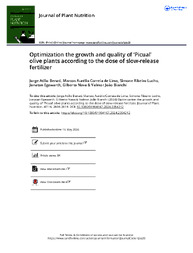Optimization the growth and quality of ‘Picual’ olive plants according to the dose of slow-release fertilizer.
Optimization the growth and quality of ‘Picual’ olive plants according to the dose of slow-release fertilizer.
Author(s): BENATI, J. A.; LIMA, M. A. C. de; LUCHO, S. R.; EGEWARTH, J.; NAVA, G.; BIANCHI, V. J.
Summary: Abstract: Due to its importance for oil production in Brazil and worldwide, the ‘Picual’ olive trees deserves special attention of to its good climatic adaptation and high yield and stability in the oil produced. However, there is a need to generate more technical information to improve the propagation and production system for nursery plants. The use of slow-release fertilizer (SRF) affects the quality standard of the plants formed in the nursery. The purpose of this study was to evaluate the effect of doses (0, 1.5, 3.0, 6.0, and 12?g L?1) of the SRF, Osmocote® (NPK 14-14-14), on morphological, biochemical and nutritional parameters of ‘Picual’ olive plants. It was found that the average value of maximum technical efficiency dose (MTED) for several morphological variables (plant height, stem diameter, total plant dry weight and root volume) was 7.18?g L?1. Furthermore, an Osmocote® dose of 8.35?g L?1 resulted in optimal leaf number and area. For the carbohydrate concentration (sucrose, starch and Total Soluble Sugar) in leaves, the best average values were obtained at 4.51, 5.48 and 6.12?g L?1 of Osmocote®, respectively. Additionally, the best growth responses of plants may also be due to increased internal macronutrient concentration such as nitrogen (N), phosphorus (P) and potassium (K) after treatment with 7.87?g L?1 of Osmocote®. The use of SRF (Osmocote®) is a viable alternative in the production of ‘Picual’ plants, as it promotes good morphological characteristics, synthesis of photosynthetic products as well as satisfactory nutritional status and plant growth.
Publication year: 2024
Types of publication: Journal article
Observation
Some of Embrapa's publications are published as ePub files. To read them, use or download one of the following free software options to your computer or mobile device. Android: Google Play Books; IOS: iBooks; Windows and Linux: Calibre.
Access other publications
Access the Agricultural Research Database (BDPA) to consult Embrapa's full library collection and records.
Visit Embrapa Bookstore to purchase books and other publications sold by Embrapa.

